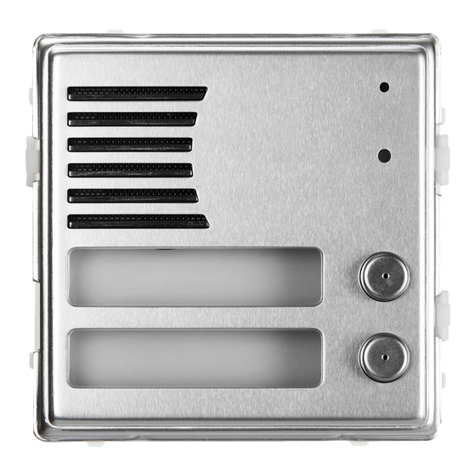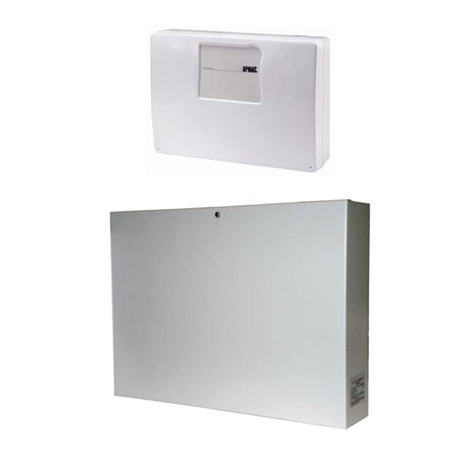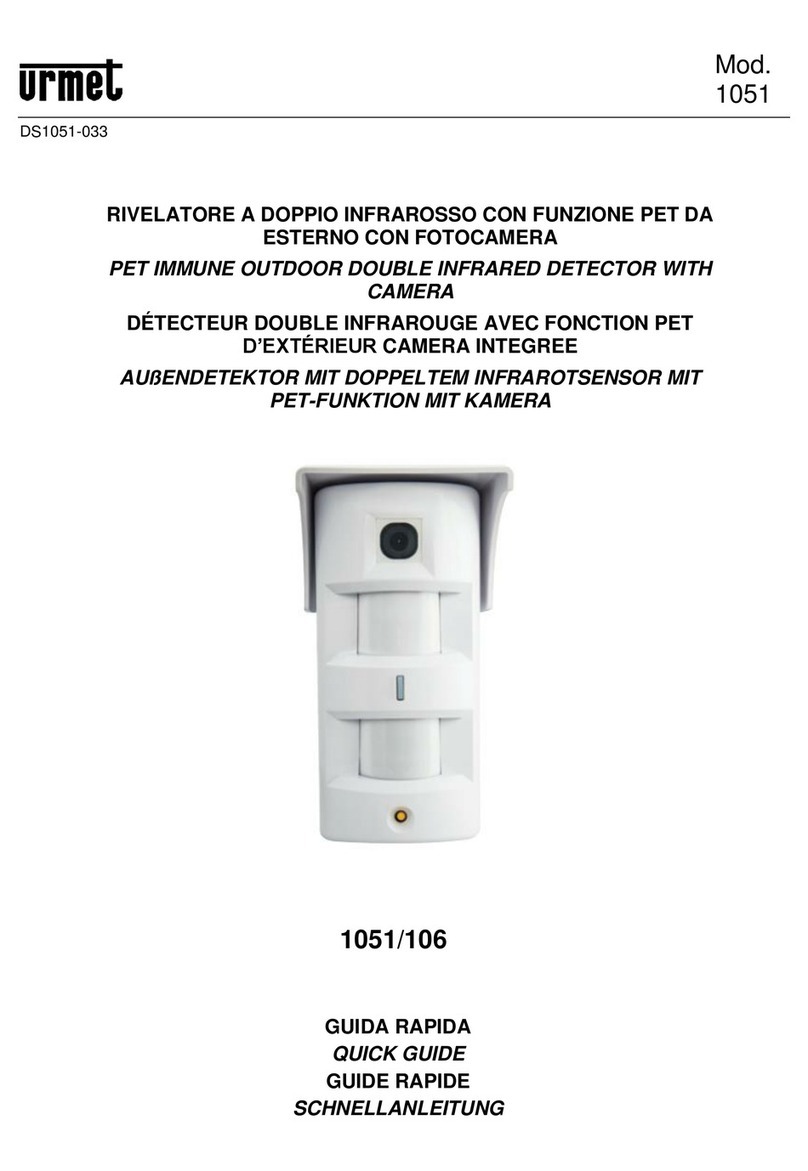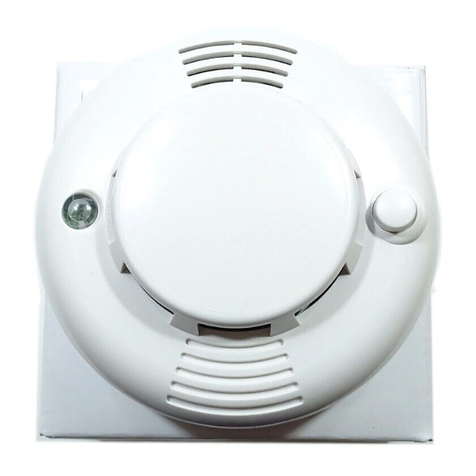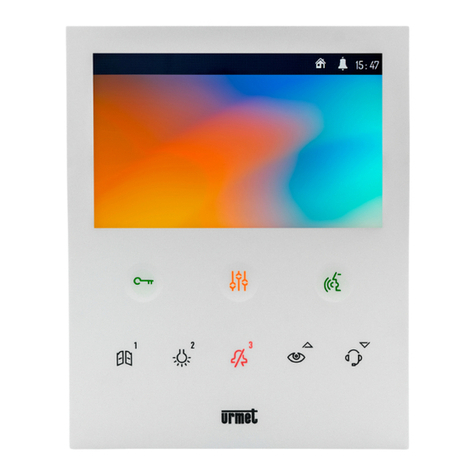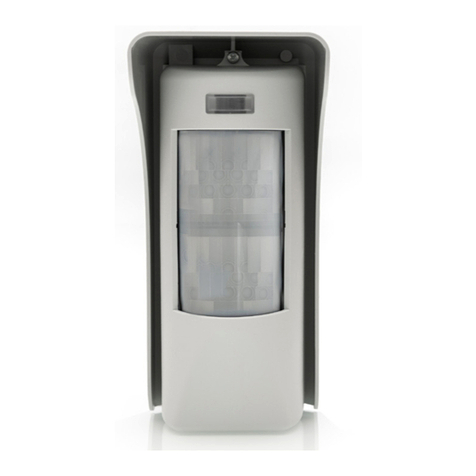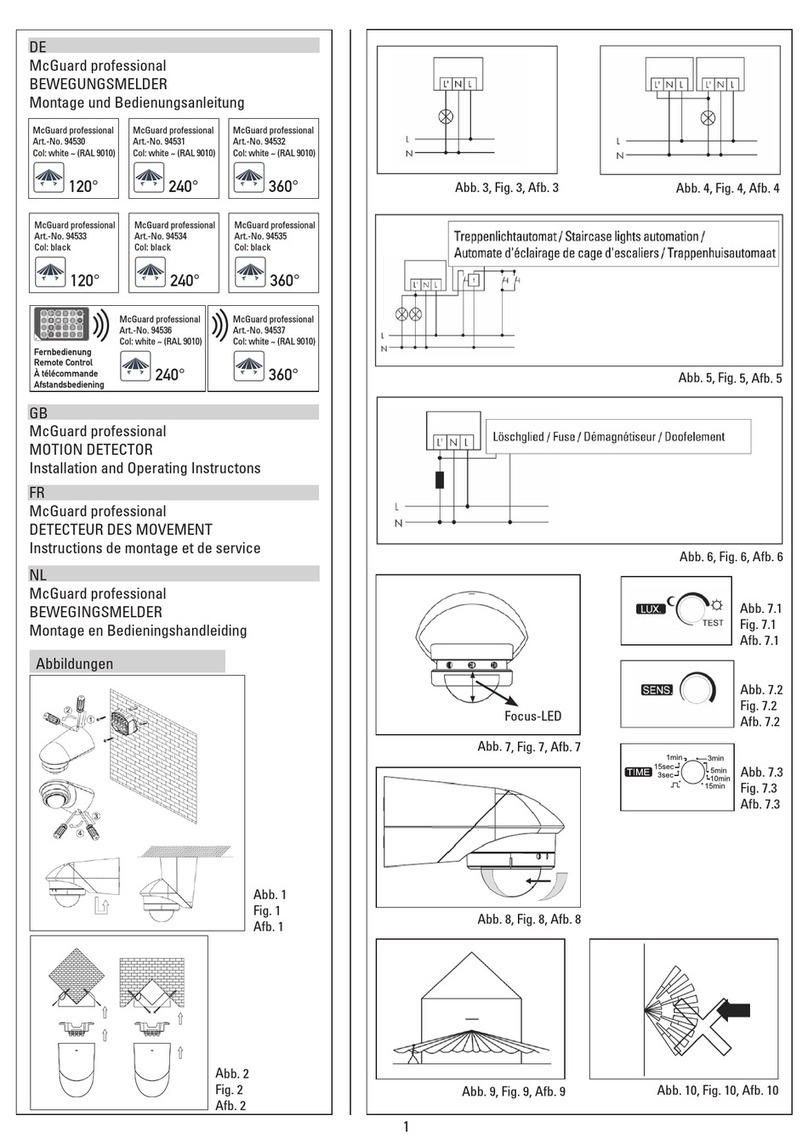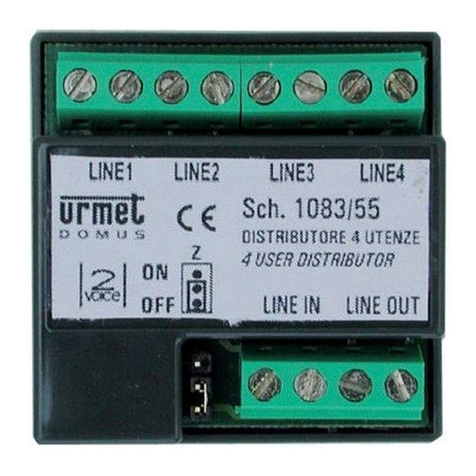
RIVELATORE DOPPIA TECNOLOGIA
PER SISTEMA ANTINTRUSIONE
DUAL-TECHNOLOGY DETECTOR
FOR ALARM SYSTEM
Sch./Ref. 1033/015
AVVERTENZE
• Installare il sensore su superfici rigide, prive di vibrazioni, ad una altezza compresa tra 2 e 2,2 m facendo
riferimento ai diagrammi di rivelazione in modo tale che il sensore riveli spostamenti che incrociano la zona
protetta e che il modulo microonda rilevi quelli in avvicinamento.
• Evitare il posizionamento del sensore vicino a fonti di calore o alla luce diretta del sole.
• Evitare la riflessione dell’energia elettromagnetica su ampie superfici quali ad esempio specchi, pareti
metalliche etc.
• Evitare di puntare il sensore su lampade fluorescenti o comunque di porlo nelle immediate vicinanze delle
stesse.
• Evitare che esistano, a causa di mobili, scaffalature, etc. zone cieche nell’area protetta entro cui possa
muoversi l’intruso.
• Evitare la presenza di animali nell’area protetta.
• E’ consigliabile utilizzare per i collegamenti un cavo schermato e preferibilmente un cavo per ogni sensore.
• Non installare più sensori nello stesso ambiente (problemi di interferenze). Non toccare con le dita la
superficie speculare del piroelettrico; nel caso, pulire con cotone ed un po’ di alcol.
• Separare per quanto possibile i conduttori dell’impianto di allarme da quelli della rete elettrica.
• Non installare il sensore all’esterno.
Nel caso di installazioni ad altezze superiori ai 2,2 m si consiglia l’utilizzo dello snodo opzionale, inclinando il
sensore in modo da adattare al meglio i campi di copertura alle effettive necessità, oppure sfruttando la
possibilità di traslare il circuito stampato verso l’alto o verso il basso riferendosi alle tacche riportate su di
esso.
INSTALLAZIONE
INSTALLAZIONE SENZA SNODO
• Per rimuovere il coperchio del sensore togliere la vite di chiusura (se inserita) e premere sul dente di
fissaggio
• Per togliere il circuito stampato estrarre la vite “G” e fare leva sul gancetto “E”.
ATTENZIONE: non toccare con le dita il sensore piroelettrico
A= PREDISPOSIZIONI PER IL FISSAGGIO AD ANGOLO
B= PREDISPOSIZIONI A SFONDAMENTO PER IL PASSAGGIO CAVI
C= PREDISPOSIZIONI PER IL FISSAGGIO SU SUPERFICIE PIANA
• Attenzione: dimensionare correttamente l’apertura in funzione del diametro del cavo, in quanto aperture
eccessive possono favorire l’entrata di flussi d’aria che generano falsi allarmi.
INSTALLAZIONE CON SNODO
E’ disponibile in opzione uno snodo (sch. 1033/139) per installazione a muro o a soffitto con kit tamper
(sch.1033/140) e passaggio cavi all’interno: per l’uso consultare le istruzioni specifiche. Per il montaggio
dello snodo, aprire l’apposita predisposizione a sfondamento “D” ed assemblare lo snodo come indicato
nelle istruzioni dello stesso. Terminato l’orientamento, volendo bloccare ulteriormente il movimento dello
snodo è possibile utilizzare la vite fornita a corredo, serrando a fondo nella sede “H”.
DESCRIZIONE MORSETTIERA
- Negativo tensione alimentazione
+ Positivo tensione alimentazione
AL Contatto NC del relè di allarme
TAMPER Contatto NC tamper
DESCRIZIONE PONTICELLI
JP1 LOGICA DI FUNZIONAMENTO AND/OR INSERITO SU POSIZIONE AND: Logica AND (Default)
INSERITO SU POSIZIONE OR: Logica OR
JP2 PORTATA SEZIONE INFRAROSSO INSERITO: PORTATA MINIMA -10m (Default)
NON INSERITO: PORTATA MASSIMA -15m
JP3 ABILITAZIONE LED DI ALLARME INSERITO: LED ABILITATO (Default)
NON INSERITO: LED NON ABILITATO
JP4 ABILITAZIONE LED DI SEZIONE INSERITO: LED ABILITATI (Default)
NON INSERITO: LED NON ABILITATI
FUNZIONI
LOGICA DI FUNZIONAMENTO
Sono previste due modalità di funzionamento a seconda della disposizione di JP1:
Logica AND: l’allarme è generato se sono sollecitate entrambe le sezioni infrarosso e microonda.
Logica OR: l’allarme è generato se sono sollecitate o la sola sezione infrarossa oppure la sola sezione
microonda.
Nota: Accertarsi che il ponticello di cortocircuito sia inserito in una delle due posizioni precedenti.
IMPOSTAZIONE PORTATA SEZIONE INFRAROSSO
Tramite JP2 (PIR RANGE) è possibile impostare la portata della sezione infrarosso del rivelatore secondo
due livelli.
Ponticello JP2 inserito: portata minima (10m nel caso di lente volumetrica - di serie)
Ponticello JP2 non inserito: portata massima (15m nel caso di lente volumetrica - di serie)
L’impostazione di fabbrica prevede il ponticello JP2 inserito.
IMPOSTAZIONE PORTATA SEZIONE MICROONDA
Tramite il trimmer MW RANGE è possibile regolare la portata della sezione microonda.
L’impostazione di fabbrica prevede la regolazione del trimmer a metà corsa.
VISUALIZZAZIONE ALLARME (WALK TEST)
Per effettuare la prova portata sono previste le segnalazioni sui LED se abilitati:
LED rosso (AL): stato dell’uscita di allarme;
LED giallo (MW): stato della sezione microonda;
LED verde (IR): stato della sezione infrarosso.
Tramite i ponticelli JP3 e JP4 è possibile disabilitare queste segnalazioni. Se necessario, regolare tramite il
trimmer la sensibilità della microonda, in modo tale che il lobo di rivelazione sia contenuto nell’area da
proteggere.
COMPENSAZIONE AUTOMATICA DELLA TEMPERATURA
Il sensore è dotato della compensazione della temperatura che permette un adattamento della sensibilità di
rivelazione alle differenti condizioni ambientali.
WARNINGS
• Place the detector on hard surfaces free from vibrations at 2 to 2.2 m height referring to coverage in order that
the detector detects movements crossing protected area and micro wave module detects approaching
movements.
• Do not locate the detector near heat sources or direct sun light.
• Prevent electromagnetic energy from reflecting on wide surfaces such as mirrors, metallic walls, etc.
• Do not aim the detector at fluorescent lamps, or anyhow place it close to them.
• Prevent furniture, shelves, etc. from creating blind zones in protected area where an intruder might move.
• Avoid the presence of animals in protected area.
• For connections, it is advisable to use a shielded cable and, preferably, one cable for each detector.
• Do not install more detectors in the same environment (owing to interference problems). Avoid to touch the
mirror-like surface of pyroelectric detector with your fingers; should it be necessary to clean it, wipe it with a
cotton cloth and little alcohol.
• Separate as much as possible alarm system leads from electric network leads.
• Do not install the detector outdoors.
In the case of installations with heights exceeding 2.2 m, it is suggested to use optional bracket, either inclining
the detector in such a way as to best adjust covering fields to actual needs or exploiting the capability to move
the printed circuit either upwards or downwards with reference to notches present on the detector.
INSTALLATION
INSTALLATION WITHOUT BRACKET
• To remove detector cover, take off closing screw (if put in) and press on fixing snap.
• To take off the printed circuit, take out screw “G” and lever on hook “E”.
CAUTION: avoid to touch the pyroelectric detector with your fingers
A= ANGLE FIXING KNOCKOUTS
B= CABLE ENTRY KNOCKOUTS
C= WALL MOUNT KNOCKOUTS
• Caution: correctly size the opening depending on cable diameter, because a too large opening may increase air
inlet generating false alarms.
INSTALLATION WITH BRACKET
An optional bracket (ref. 1033/139) is available for wall or ceiling mounting with tamper kit (ref.1033/140) and
internal cable passage: for use, read specific instructions. To mount the bracket, open special breaking
prearrangement “D” and assemble the articulated joint as indicated in product instructions. After orientation has
been terminated, if you want further block bracket movement, provided screw can be used tightening up in seat
“H”.
TERMINAL BLOCKS DESCRIPTION
- Negative supply
+ Positive supply
AL Alarm relay NC contact
TAMPER Tamper NC contact
JUMPERS DESCRIPTION
JP1 AND/OR OPERATION LOGIC INSERTED TO POSITION AND: AND Logic (Default)
INSERTED TO POSITION OR: OR Logic
JP2 INFRARED SECTION RANGE INSERTED: MINIMUM RANGE -10m (Default)
NOT INSERTED: MAXIMUM RANGE -15m
JP3 ALARM LED ENABLING INSERTED: LED ENABLED (Default)
NOT INSERTED: LED NOT ENABLED
JP4 SECTION LED ENABLING INSERTED: LED’s ENABLED (Default)
NOT INSERTED: LED’s NOT ENABLED
FUNCTIONS
OPERATION LOGIC
Two operation modes are provided for, depending on JP1 arrangement:
AND Logic: alarm is generated if both infrared and micro wave sections are affected.
OR Logic: alarm is only generated if either infrared or micro wave section is singularly affected.
Note: Ensure that short circuit jumper is inserted to either above position.
SETTING INFRARED SECTION RANGE
Via JP2 (PIR RANGE),detector infrared section range can be set according two levels.
JP2 jumper inserted: minimum range (10m for series wide angle lens).
JP2 jumper not inserted: maximum range (15m for series wide angle lens).
Workshop setting is with JP2 jumper inserted.
SETTING MICROWAVE SECTION RANGE
Via MW RANGE trimmer, micro wave section range can be adjusted.
Workshop setting is with half travel trimmer adjustment.
WALK TEST
To perform the test, signalling on LED’s is provided for, provided that they are enabled:
red (AL) LED: alarm output status;
yellow (MW) LED: micro wave section status;
green (IR) LED: infrared wave section status.
Via JP3 and JP4 jumpers, above signalling can be disabled. If necessary, adjust: micro wave sensitivity via the
trimmer, in such a way that detection lobe is contained in area to be protected.
TEMPERATURE AUTOMATIC COMPENSATION
The detector is provided with temperature compensation allowing an equalization of detection sensitivity to the
different environmental conditions.
G
LBT8491
DS1033-130
GB
I
B
B
D
E
F
B
C
H
B
INSTALLAZIONE
INSTALLATION

